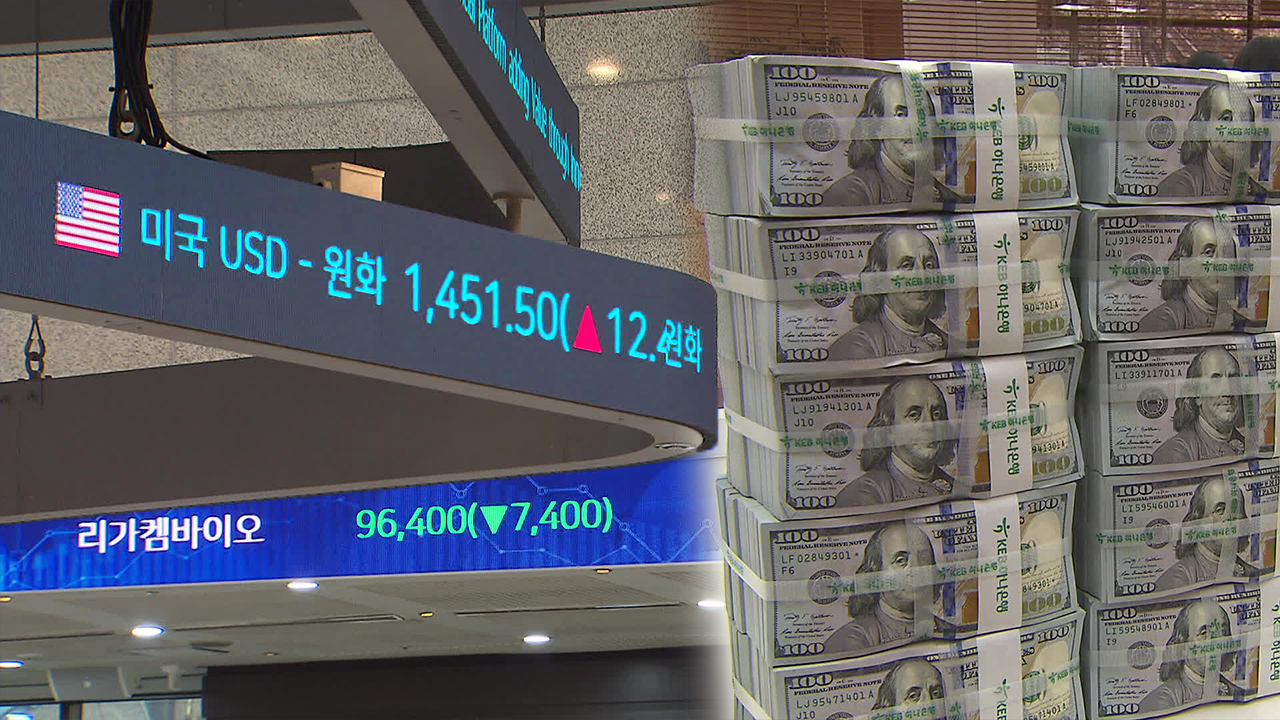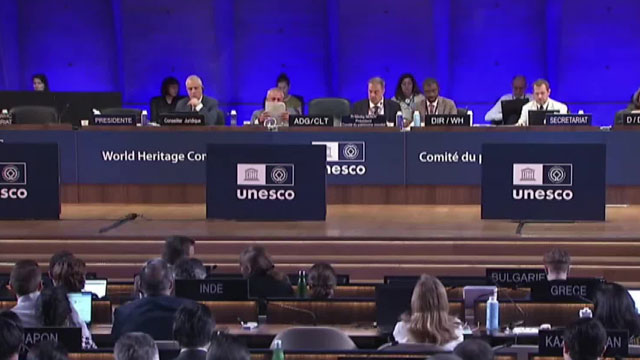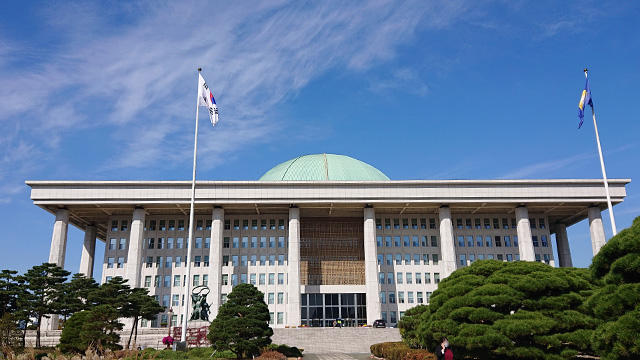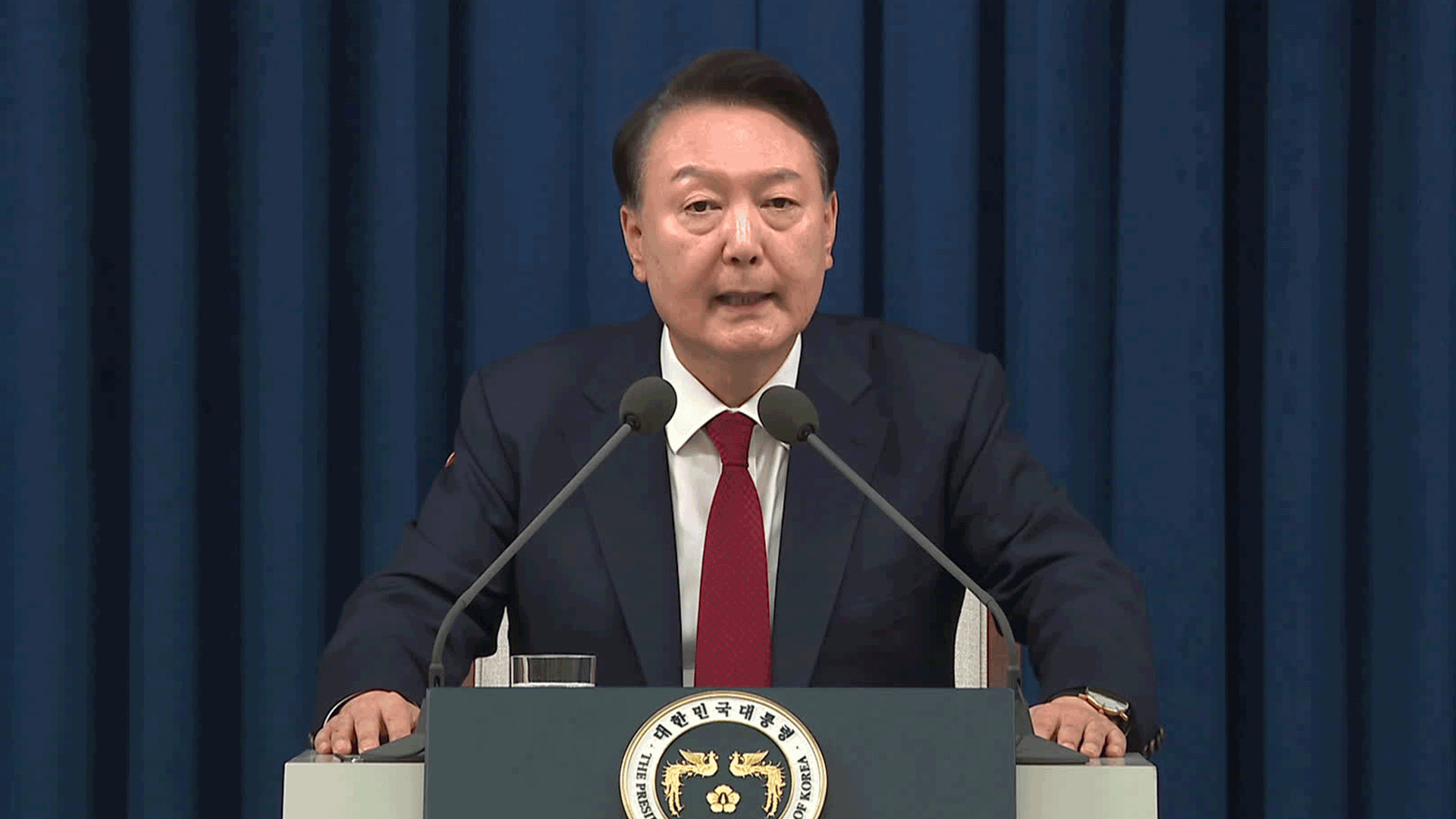Won-dollar exchange rate surpasses 1,450 won after U.S. Federal Reserve's rate cut forecast
입력 2024.12.19 (23:55)
읽어주기 기능은 크롬기반의
브라우저에서만 사용하실 수 있습니다.
[Anchor]
Today (12.19), the won-dollar exchange rate has surpassed 1,450 won, reaching its highest level in 15 years and 9 months.
The soaring exchange rate has become the biggest economic concern as we approach the end of the year, and we will examine the causes and impacts of this rapid increase from various angles.
First, we have Hwang Hyun-kyu's report.
[Report]
In the early hours of December 4, right after the martial law was declared.
The won-dollar exchange rate surged, but it maintained the 1,450 won level at that time.
The one that caused the exchange rate to break through this level was the U.S. Federal Reserve.
The Fed lowered the U.S. benchmark interest rate by 0.25 percentage points, but the exchange rate was more influenced by next year's outlook than by this cut.
The initial forecast of four rate cuts next year was revised down to two.
This indicates that U.S. interest rates will decrease more slowly than expected.
Concerns grew that more money would flow into the U.S.
This is the reason why the exchange rate rose to its highest level since March 13, 2009, reaching 1,451 won.
It would be too simplistic to attribute this to short-term negative factors like martial law and impeachment, as the trend of the exchange rate is unusual.
Looking at the long-term trend, from the 1980s to 1997, it was stable in the 800 won range, but everyone remembers the 1997 financial crisis, which caused a sharp increase.
Again, during the 2008 financial crisis, it also exceeded 1,500 won.
Now, more than ten years later, it has surpassed 1,450 won and is close to 1,500 won.
At a glance, it seems like 1997 was Mount Baekdu, 2008 was Mount Hallasan, and now we are at the height of Jirisan.
A bigger concern is that the pressure for the exchange rate to rise is coming from the U.S., which we cannot control.
The heads of economic research institutes from eight companies, including Samsung and Hyundai, have also agreed that the exchange rate has become the biggest risk factor.
This is KBS News, Hwang Hyun-kyu.
Today (12.19), the won-dollar exchange rate has surpassed 1,450 won, reaching its highest level in 15 years and 9 months.
The soaring exchange rate has become the biggest economic concern as we approach the end of the year, and we will examine the causes and impacts of this rapid increase from various angles.
First, we have Hwang Hyun-kyu's report.
[Report]
In the early hours of December 4, right after the martial law was declared.
The won-dollar exchange rate surged, but it maintained the 1,450 won level at that time.
The one that caused the exchange rate to break through this level was the U.S. Federal Reserve.
The Fed lowered the U.S. benchmark interest rate by 0.25 percentage points, but the exchange rate was more influenced by next year's outlook than by this cut.
The initial forecast of four rate cuts next year was revised down to two.
This indicates that U.S. interest rates will decrease more slowly than expected.
Concerns grew that more money would flow into the U.S.
This is the reason why the exchange rate rose to its highest level since March 13, 2009, reaching 1,451 won.
It would be too simplistic to attribute this to short-term negative factors like martial law and impeachment, as the trend of the exchange rate is unusual.
Looking at the long-term trend, from the 1980s to 1997, it was stable in the 800 won range, but everyone remembers the 1997 financial crisis, which caused a sharp increase.
Again, during the 2008 financial crisis, it also exceeded 1,500 won.
Now, more than ten years later, it has surpassed 1,450 won and is close to 1,500 won.
At a glance, it seems like 1997 was Mount Baekdu, 2008 was Mount Hallasan, and now we are at the height of Jirisan.
A bigger concern is that the pressure for the exchange rate to rise is coming from the U.S., which we cannot control.
The heads of economic research institutes from eight companies, including Samsung and Hyundai, have also agreed that the exchange rate has become the biggest risk factor.
This is KBS News, Hwang Hyun-kyu.
■ 제보하기
▷ 카카오톡 : 'KBS제보' 검색, 채널 추가
▷ 전화 : 02-781-1234, 4444
▷ 이메일 : kbs1234@kbs.co.kr
▷ 유튜브, 네이버, 카카오에서도 KBS뉴스를 구독해주세요!
- Won-dollar exchange rate surpasses 1,450 won after U.S. Federal Reserve's rate cut forecast
-
- 입력 2024-12-19 23:55:00

[Anchor]
Today (12.19), the won-dollar exchange rate has surpassed 1,450 won, reaching its highest level in 15 years and 9 months.
The soaring exchange rate has become the biggest economic concern as we approach the end of the year, and we will examine the causes and impacts of this rapid increase from various angles.
First, we have Hwang Hyun-kyu's report.
[Report]
In the early hours of December 4, right after the martial law was declared.
The won-dollar exchange rate surged, but it maintained the 1,450 won level at that time.
The one that caused the exchange rate to break through this level was the U.S. Federal Reserve.
The Fed lowered the U.S. benchmark interest rate by 0.25 percentage points, but the exchange rate was more influenced by next year's outlook than by this cut.
The initial forecast of four rate cuts next year was revised down to two.
This indicates that U.S. interest rates will decrease more slowly than expected.
Concerns grew that more money would flow into the U.S.
This is the reason why the exchange rate rose to its highest level since March 13, 2009, reaching 1,451 won.
It would be too simplistic to attribute this to short-term negative factors like martial law and impeachment, as the trend of the exchange rate is unusual.
Looking at the long-term trend, from the 1980s to 1997, it was stable in the 800 won range, but everyone remembers the 1997 financial crisis, which caused a sharp increase.
Again, during the 2008 financial crisis, it also exceeded 1,500 won.
Now, more than ten years later, it has surpassed 1,450 won and is close to 1,500 won.
At a glance, it seems like 1997 was Mount Baekdu, 2008 was Mount Hallasan, and now we are at the height of Jirisan.
A bigger concern is that the pressure for the exchange rate to rise is coming from the U.S., which we cannot control.
The heads of economic research institutes from eight companies, including Samsung and Hyundai, have also agreed that the exchange rate has become the biggest risk factor.
This is KBS News, Hwang Hyun-kyu.
Today (12.19), the won-dollar exchange rate has surpassed 1,450 won, reaching its highest level in 15 years and 9 months.
The soaring exchange rate has become the biggest economic concern as we approach the end of the year, and we will examine the causes and impacts of this rapid increase from various angles.
First, we have Hwang Hyun-kyu's report.
[Report]
In the early hours of December 4, right after the martial law was declared.
The won-dollar exchange rate surged, but it maintained the 1,450 won level at that time.
The one that caused the exchange rate to break through this level was the U.S. Federal Reserve.
The Fed lowered the U.S. benchmark interest rate by 0.25 percentage points, but the exchange rate was more influenced by next year's outlook than by this cut.
The initial forecast of four rate cuts next year was revised down to two.
This indicates that U.S. interest rates will decrease more slowly than expected.
Concerns grew that more money would flow into the U.S.
This is the reason why the exchange rate rose to its highest level since March 13, 2009, reaching 1,451 won.
It would be too simplistic to attribute this to short-term negative factors like martial law and impeachment, as the trend of the exchange rate is unusual.
Looking at the long-term trend, from the 1980s to 1997, it was stable in the 800 won range, but everyone remembers the 1997 financial crisis, which caused a sharp increase.
Again, during the 2008 financial crisis, it also exceeded 1,500 won.
Now, more than ten years later, it has surpassed 1,450 won and is close to 1,500 won.
At a glance, it seems like 1997 was Mount Baekdu, 2008 was Mount Hallasan, and now we are at the height of Jirisan.
A bigger concern is that the pressure for the exchange rate to rise is coming from the U.S., which we cannot control.
The heads of economic research institutes from eight companies, including Samsung and Hyundai, have also agreed that the exchange rate has become the biggest risk factor.
This is KBS News, Hwang Hyun-kyu.
-
-

황현규 기자 help@kbs.co.kr
황현규 기자의 기사 모음
-
이 기사가 좋으셨다면
-
좋아요
0
-
응원해요
0
-
후속 원해요
0












![[단독] 김건희 특검, ‘공천 개입’ 관련 김영선 전 의원 소환 통보…일정 조율 중](/data/news/2025/07/16/20250716_p7hDHF.jpg)


이 기사에 대한 의견을 남겨주세요.